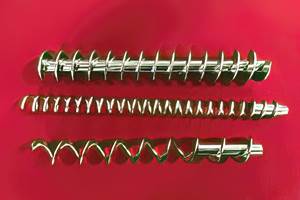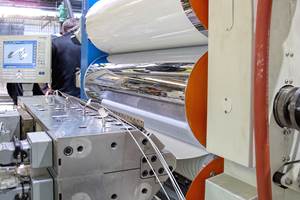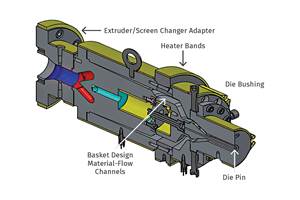Extrusion: Take Care of Your Rolls So They Can Play Their Role
In the sheet extrusion 911±¬ÁĎÍř, one of your most important manufacturing assets is your cooling rolls.
In the sheet extrusion 911±¬ÁĎÍř, one of your most important manufacturing assets is your cooling rolls. They play a critical role in determining the dimensions and quality of your product. But many operating personnel tend to think of them as indestructible items just as good for crushing rocks as making plastic sheet. Nothing could be farther from the truth. Rolls are surprisingly complicated and fragile devices, and you need to take great care not to disfigure them.
Although they look very robust and strong from the outside, they are in fact hollow and are quite easily dented and distorted. Once damaged, they can never again make quality sheet until they are repaired or replaced. Additionally, dinged-up rolls will cause operators fits as they try to maintain gauge and surface quality. The reason they are not as robust and strong as they appear is that the heat-transfer rate is reduced as you increase the thickness of the outer shell. So making them stronger reduces their ability to perform their main function, which is to cool the sheet. The accompanying illustration shows the configuration of a typical sheet cooling roll.
Just inside the outer shell is the coolant, which extracts the heat absorbed from the hot plastic. Inside that is an inner shell, which contains the coolant and adds some support to the outer shell via the spiral wraps that form the coolant passages. The roll is designed to support the load imposed by the roll-closing cylinders. But that load is meant to be distributed across the whole face of the roll. A typical, recently built sheet line may have 350 to 600 pli (pounds per linear inch of roll face). If it is a 600-pli line and the rolls are 60-in. wide, the total closing force (pneumatic or hydraulic) would be approximately 36,000 lb. That presents no problem to the roll when that force is distributed across most of the roll face. However when a hard object is passed through the rolls (such as a lump of hard plastic) that is thicker than the roll gap, all of that force is concentrated on that spot.
If, for example, the object was 0.5 in. wide, the roll would be subjected to a concentrated load of at least 72,000 psi, and probably a lot more because the curved surfaces of the rolls do not allow for much distribution of the load in the machine direction. As a result, the concentrated load could be 150,000 psi or more, exceeding the strength of the steel. That is often enough force to collapse the outer shell in the spacing between the outer wraps, putting a permanent dent in the roll. In severe cases it an also collapse the inner shell, causing a much larger permanent dent in the roll.
If the hard lump is thick enough it can also cause the roll to twist much like when you twist a soda can in your hands. This happens because the movable roll has to climb over the lump in order to keep turning and the drive chain is holding it down. Due to the enormous pulling force of the chain, a very large torque develops in the roll shells between the drive sprocket and the location of the lump. This causes the roll to develop several high spots and low spots that are again permanent deformations and will cause the sheet gauge to vary and the process to be very unstable.
Nothing that is hard and thicker than the roll gap should ever be put through the rolls in their closed position. The best way to string up the line is to extrude melt onto a flat, smooth sheet of plastic that is the width of the sheet to be made. Use the pull rolls to pull the sheet and as soon as the melted “blob” passes through the roll gaps, the rolls can be closed. Never close the rolls on a rope or other pulling device. Even if the rope is thinner than the roll gap, the knot isn’t.
About the Author
Jim Frankland is a mechanical engineer who has been involved in all types of extrusion processing for more than 40 years. He is now president of Frankland Plastics Consulting, LLC. Contact jim.frankland@comcast.net or (724)651-9196.
Related Content
What to Know About Your Materials When Choosing a Feeder
Feeder performance is crucial to operating extrusion and compounding lines. And consistent, reliable feeding depends in large part on selecting a feeder compatible with the materials and additives you intend to process. Follow these tips to analyze your feeder requirements.
Read MoreRoll Cooling: Understand the Three Heat-Transfer Processes
Designing cooling rolls is complex, tedious and requires a lot of inputs. Getting it wrong may have a dramatic impact on productivity.
Read MoreHow to Select the Right Tooling for Pipe Extrusion
In pipe extrusion, selecting or building a complementary set of tooling often poses challenges due to a range of qualitative factors. Here’s some guidance to help you out.
Read MoreNPE2024 Wrap-Up: Sustainability Dominates Show Floor News
Across all process types, sustainability was a big theme at NPE2024. But there was plenty to see in automation and artificial intelligence as well.
Read MoreRead Next
See Recyclers Close the Loop on Trade Show Production Scrap at NPE2024
A collaboration between show organizer PLASTICS, recycler CPR and size reduction experts WEIMA and Conair recovered and recycled all production scrap at NPE2024.
Read MoreMaking the Circular Economy a Reality
Driven by brand owner demands and new worldwide legislation, the entire supply chain is working toward the shift to circularity, with some evidence the circular economy has already begun.
Read More.jpg;width=70;height=70;mode=crop)











